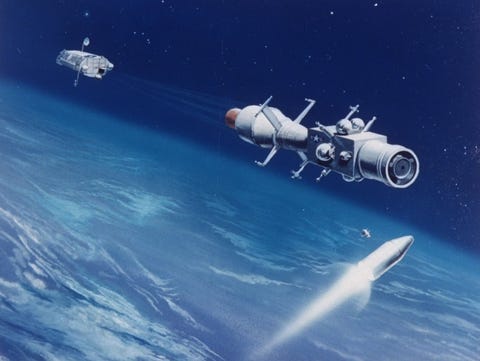Shooting Down Nukes From Space Is Harder Than It Sounds
Three decades after Reagan's "Star Wars," putting missile interceptors in orbit is still a bad idea.
By Kyle Mizokami TIME LIFE PICTURES
TIME LIFE PICTURESCould Uncle Sam shoot down Kim Jong-un's nukes from space? Perhaps not.
For decades, the United States has pondered deploying a space-based ballistic missile defense system. Hundreds of satellites, each armed with interceptor rockets, would safeguard America from attack by shooting down nuclear-tipped missiles as they rose up up from the Earth. But the idea has never been practical, and according to the Union of Concerned Scientists, this strategy hasn’t gotten any easier even against relatively small nuclear powers such as North Korea.
During the 1980s, the Pentagon’s Strategic Defense Initiative, derisively nicknamed “Star Wars,” sought to figure out how to protect the United States from missile attack. SDI researched and studied chemical interceptor rockets, particle beams, and even lasers. The government eventually decided that few of the technologies were ready and that fielding an effective missile defense system was simply too expensive. Their consolation prize was the Ground Based Midcourse Defense, an anti-missile system based in Alaska meant to protect the U.S. from a mere handful of missiles.
How much has changed in the three decades since Reagan? Not so much, it seems. Writing in the Union of Concerned Scientists’ All Things Nuclear blog, physicist David Wright explains that, despite technical advances of the past 30 years, space-based missile defense is still impractical.
The idea is still a clever one. A space-based system is ideal because satellites armed with interceptors can shoot down missiles in the so-called “boost phase” when they have just lifted off from the ground. This is particularly important because some modern missiles carry multiple warheads that separate from the missile just after boost phase. Kill one missile in boost phase and you save yourself the work of tracking down and killing all of the individual warheads.
However, several huge problems with space-based systems, Wright says. One is the sheer number of sats: To properly cover the space above North Korea, you’d need 300 to 400 orbiters in a never-ending train of killer satellites constantly passing over the reclusive nuclear state. Even an “austere and limited” capability, which sounds like something useful against North Korea's small missile arsenal, would cost somewhere in the neighborhood of $300 billion. Against larger adversaries, you’d need 1,200 or more satellites and upwards of a trillion dollars.
Another problem with putting interceptors in space: the enemy would be able to track them and would know exactly where they are, putting them at risk of being downed by anti-satellite weapons. An adversary, having created a blind spot in the network, could then launch a timed attack.
Missile defense has a high tech feel to it, but it’s still much too expensive and in the end vulnerable to attacks. The past 30 years haven't really done much to make space-based defense practical.
Read more at All Things Nuclear.
No comments:
Post a Comment